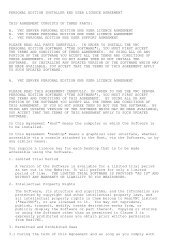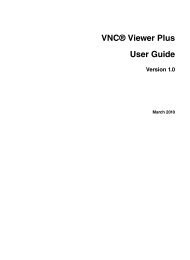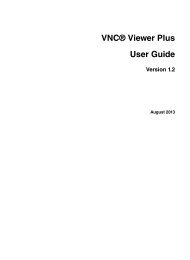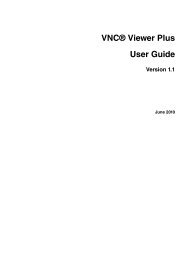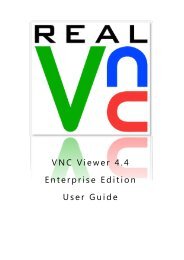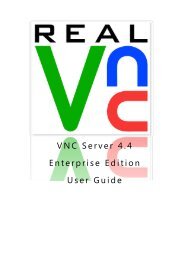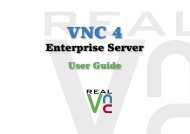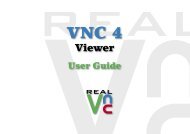VNC User Guide - RealVNC
VNC User Guide - RealVNC
VNC User Guide - RealVNC
You also want an ePaper? Increase the reach of your titles
YUMPU automatically turns print PDFs into web optimized ePapers that Google loves.
Chapter 2: Getting Connected<br />
b. Examine the appropriate section of the Get Started section:<br />
In this example, <strong>VNC</strong> Server is running on host computer 192.168.0.133 and listening on port 5901.<br />
Allowing network communications through a firewall<br />
If the host computer is protected by a firewall, then the firewall must be configured to allow incoming network<br />
communications to the port on which <strong>VNC</strong> Server is listening. To find out which port this is, see Qualifying a<br />
network address with a port number on page 30.<br />
The firewall might be automatically configured by the operating system of the host computer. If not, you will<br />
probably see the following error message when you connect from <strong>VNC</strong> Viewer:<br />
Connection timed out (10060)<br />
The instructions for adding exceptions for ports are specific to firewalls. If you do not have access to the host<br />
computer, ask a host computer user to consult the manufacturer’s documentation.<br />
Miscellaneous connection messages<br />
This section explains various error messages you might see.<br />
Failing to authenticate correctly<br />
If you see the following error message:<br />
Either the username was not recognized, or the password was incorrect.<br />
then you have not authenticated correctly to <strong>VNC</strong> Server. Note that user names and passwords are casesensitive.<br />
If you do not know the correct user name or password, and you do not have access to the host computer,<br />
you will need to consult your system administrator or a host computer user. If you do have access to the host<br />
computer, and sufficient privileges to configure <strong>VNC</strong> Server, you may be able to relax the authentication<br />
rules. For more information, see Relaxing the authentication rules on page 104.<br />
Failing to authenticate as ‘you’<br />
If you see the following error message:<br />
Access is denied.<br />
then <strong>VNC</strong> Server has been configured to require the credentials of a host computer user. Your user name<br />
and password, however, have not been added to the authentication list.<br />
If this is the case and you do not have access to the host computer, you will need to consult your system<br />
administrator or a host computer user. If you do have access to the host computer, and sufficient privileges<br />
to configure <strong>VNC</strong> Server, you may be able to register your credentials. For more information, see Managing<br />
users and groups in the authentication list on page 102.<br />
<strong>VNC</strong> <strong>User</strong> <strong>Guide</strong> 31



